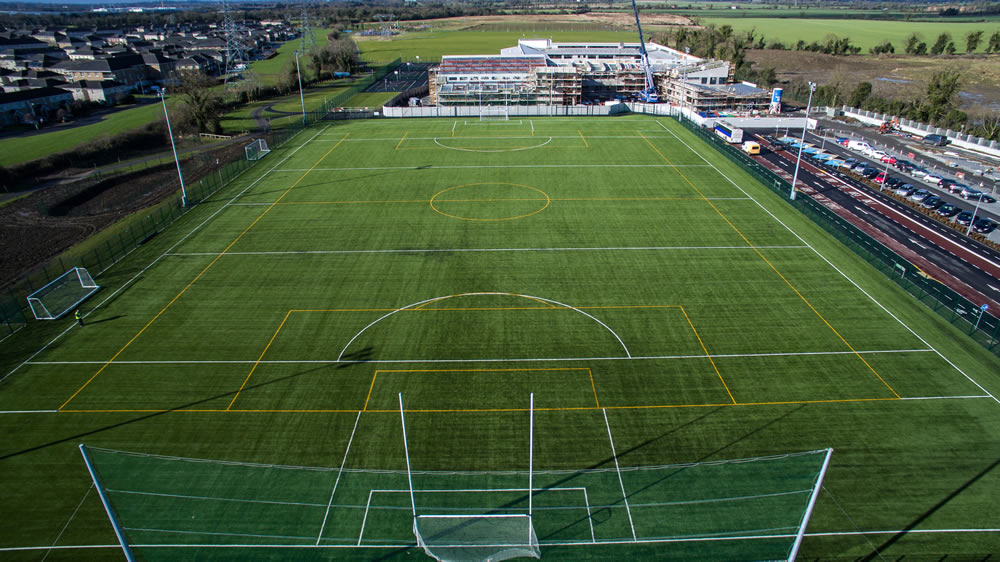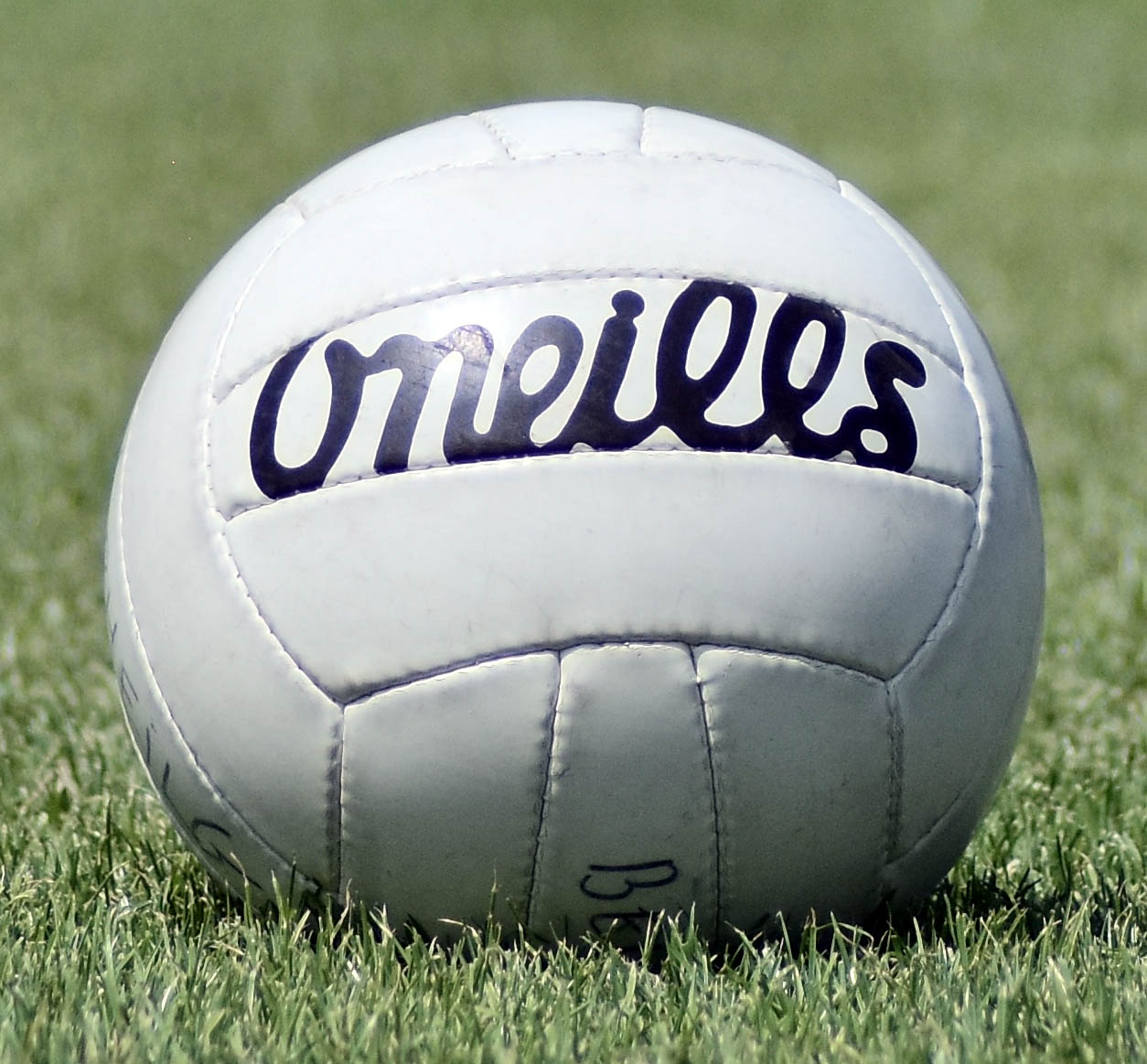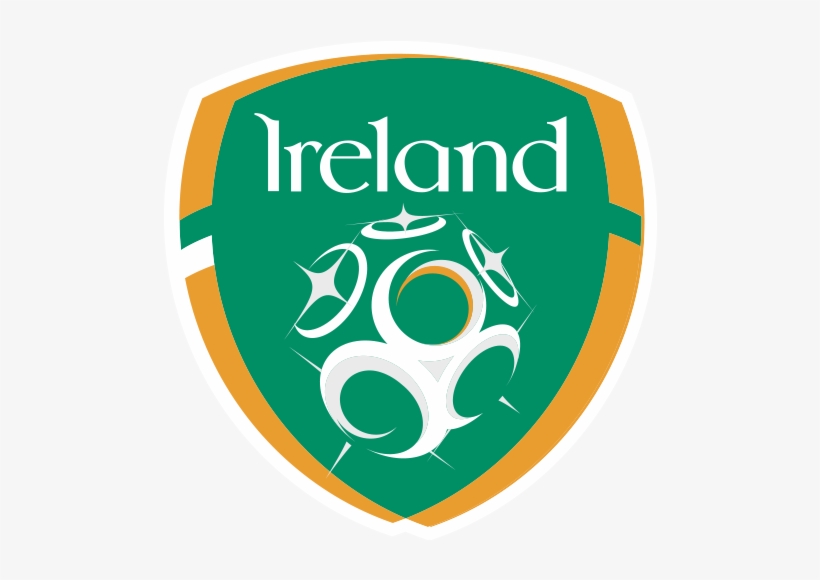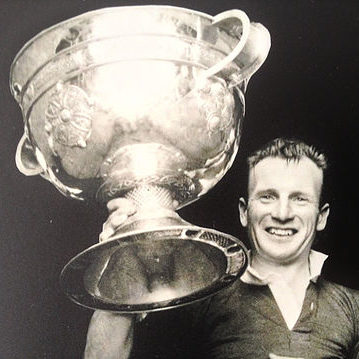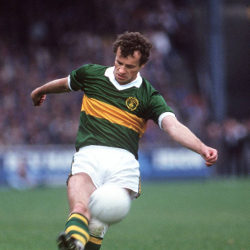Playing field
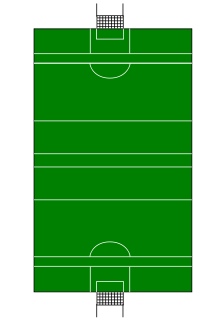
Diagram of a Gaelic football pitch
A Gaelic pitch is similar in some respects to a rugby pitch but larger. The grass pitch is rectangular, stretching 130–145 metres (142–159 yards) long and 80–90 m (87–98 yd) wide. There are H-shaped goalposts at each end, formed by two posts, which are usually 6–7 metres (20–23 feet) high, set 6.5 m (21 ft) apart, and connected 2.5 m (8.2 ft) above the ground by a crossbar. A net extending behind the goal is attached to the crossbar and lower goal posts. The same pitch is used for hurling; the GAA, which organises both sports, decided this to facilitate dual usage. Lines are marked at distances of 13 metres, 20 metres, and 45 metres (65 m in hurling) from each end-line. Shorter pitches and smaller goals are used by youth teams.
Duration
The majority of adult football and all minor and under-21 matches last for 60 minutes, divided into two halves of 30 minutes, with the exception of senior inter-county games, which last for 70 minutes (two halves of 35 minutes). Draws are decided by replays or by playing 20 minutes of extra time (two halves of 10 minutes). Juniors have a half of 20 minutes or 25 minutes in some cases. Half-time lasts for about 5 or 10 minutes.
Teams
Teams consist of fifteen players (a goalkeeper, two corner backs, a full back, two wing backs, a centre back, two mid fielders, two wing forwards, a centre forward, two corner forwards and a full forward) plus up to fifteen substitutes, of which six may be used. As for younger teams or teams that do not have enough players for fifteen aside, it is not uncommon to play thirteen aside (the same positions except without the full back and the full forward). Each player is numbered 1–15, starting with the goalkeeper, who must wear a jersey colour different from that of his or her teammates. Up to 15 substitutes may be named on the team sheet, number 16 usually being the reserve goalkeeper.
Positions
Ball

The ball used for a match, made by Irish company O’Neills
The game is played with a round leather football made of 18 stitched leather panels, similar in appearance to a traditional volleyball (but larger), with a circumference of 68–70 cm (27–28 in), weighing between 480–500 g (17–18 oz) when dry. It may be kicked or hand passed. A hand pass is not a punch but rather a strike of the ball with the side of the closed fist, using the knuckle of the thumb.
Mark
In 2017, the GAA introduced the ‘mark’ across the board in Gaelic football. Similar to the mark in Australian rules football, a player who catches the ball from a kick-out is awarded a free kick. The rule in full states: “When a player catches the ball cleanly from a Kick-Out without it touching the ground, on or past the 45 m line nearest the Kick Out point, he shall be awarded ‘a Mark’ by the Referee. The player awarded a ‘Mark’ shall have the options of (a) Taking a free kick or (b) Playing on immediately.” In comparison, the Australian rules equivalent requires the ball not to have touched the ground and for the kick to have travelled at least 15 metres. In the experimental rules of 2019 a player can now also call a mark inside the opposition’s 45-metre line after a clean catch from a kick played over 20 metres from outside the 45 metre line that doesn’t touch the ground or any other player.
Types of fouls
There are three main types of fouls in Gaelic Football, which can result in the ball being given to the other team, a player being cautioned, a player being removed from the field, or even the game being terminated.
Technical fouls
The following are considered technical fouls (“fouling the ball”):
- Going five steps without releasing, bouncing or soloing the ball (soloing involves kicking the ball into one’s own hands)
- Bouncing the ball twice in a row (It may be soloed continuously)
- Changing hands: Throwing the ball from your right hand to left or vice versa (legal in the ladies’ game)
- Throwing the ball (it may be “hand-passed” by striking with the fist).
- Hand passing a goal. To hand pass a ball with an open palm there must be a clear striking action (the ball may be punched over the bar from up in the air, but not into the goal).
- Picking the ball directly off the ground (it must be scooped up into the hands by the foot). However, in ladies’ Gaelic football the ball may be picked up directly.
- Square ball is an often controversial rule: “If, at the moment the ball enters the small square, there is already an attacking player inside the small rectangle, then a free out is awarded.” As of 2012 square balls are only counted if the player is inside the square when the ball is kicked from a free or set piece. An opposing player is allowed in the square during open play.
Aggressive fouls
Aggressive fouls are physical or verbal fouls committed by a player against an opponent or the referee. The player can be cautioned (shown a yellow card), ordered off the pitch without a substitute (red card), or (beginning 1 January 2014) ordered off the pitch with a substitution (black card).
Players are cautioned by a yellow card, ordered off the pitch without a substitute by a red card, or ordered off the pitch with a substitution by a black card.
Dissent
A dissent foul is a foul where a player fails to comply with the officials’ judgment and/or instructions. The player can be cautioned (shown a yellow card), ordered off the pitch without a substitute (red card), the free kick placement moved 13 m further down-field, or in certain circumstances, the game can be terminated. The following are considered dissent fouls:
- To challenge the authority of a referee, umpire, linesman or sideline official.
- To fail to comply with a referee’s instruction to use a mouth guard.
- To refuse to leave the field of play, on the instruction of the referee, for attention, after an injury involving bleeding.
- To show dissent with the referee’s decision to award a free kick to the opposing team.
- To refuse to leave the field of play when ordered off (red card) or rejoin the game after being ordered off.
- A team or player(s) leaving the field without the referee’s permission or refusing to continue playing.
Scoring
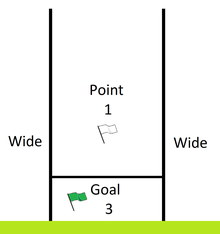
Goalposts and scoring in Gaelic football
If the ball goes over the crossbar, a point is scored and a white flag is raised by an umpire. A point is scored by either kicking the ball over the crossbar, or fisting it over, in which case the hand must be closed while striking the ball. If the ball goes below the crossbar, a goal, worth three points, is scored, and a green flag is raised by an umpire. A goal is scored by kicking the ball into the net, not by fist passing the ball into it. However, a player can strike the ball into the net with a closed fist if the ball was played to him by another player or came in contact with the post/crossbar/ground prior to connection. The goal is guarded by a goalkeeper. Scores are recorded in the format Goal Total-Point Total. To determine the score-line goals must be converted to points and added to the other points. For example, in a match with a final score of Team A 0–21 Team B 4–8, Team A is the winner with 21 points, as Team B scored only 20 points (4 times 3, plus 8).
Tackling
The level of tackling allowed is less robust than in rugby.
Shoulder to shoulder contact and slapping the ball out of an opponent’s hand are permitted, but the following are all fouls:
- Blocking a shot with the foot
- Pulling an opponent’s jersey
- Pushing an opponent
- Sliding tackles
- Striking an opponent
- Touching the goalkeeper when he/she is inside the small rectangle
- Tripping
- Using both hands to tackle
- Wrestling the ball from an opponent’s hands
Restarting play
- A match begins with the referee throwing the ball up between the four mid fielders.
- After an attacker has put the ball wide of the goals or scored a point or a goal, the goalkeeper may take a kick out from the ground at the 13 m line. All players must be beyond the 20 m line. However, in the 2019 experimental rules (rules tested in pre-season competitions), kick-outs must be taken from the 20-metre line.
- After a defender has put the ball wide of the goals, an attacker may take a “45” from the ground on the 45 m line, level with where the ball went wide.
- After a player has put the ball over the sideline, the other team may take a sideline kick at the point where the ball left the pitch. It may be kicked from the ground or the hands. The player who is taking the sideline kick must not pass the boundary line while taking.
- After a player has committed a foul, the other team may take a free kick (usually shortened to “free” in reports/commentaries) at the point where the foul was committed. It may be kicked from the ground or the hands.
- If a player has been fouled while passing the ball, the free may be taken from the point where the ball landed.
- After a defender has committed a foul inside the large rectangle, the other team may take a penalty kick from the ground from the centre of the 11 m line. Only the goalkeeper may guard the goals.
- If many players are struggling for the ball and it is not clear who was fouled first, the referee may choose to throw the ball up between two opposing players.
Officials
A football match is overseen by up to eight officials:
- The referee
- Two linesmen
- Sideline official/Standby linesman (often referred to as “fourth official”; inter-county games only)
- Four umpires (two at each goal)
The referee is responsible for starting and stopping play, recording the score, awarding frees and booking and sending off players.
Linesmen are responsible for indicating the direction of line balls to the referee.
The fourth official is responsible for overseeing substitutions, and also indicating the amount of stoppage time (signalled to him by the referee) and the players substituted using an electronic board.
The umpires are responsible for judging the scoring. They indicate to the referee whether a shot was: wide (spread both arms), a 45 m kick (raise one arm), a point (wave white flag), square ball (cross arms) or a goal (wave green flag). A disallowed score is indicated by crossing the green and white flags.
Other officials are not obliged to indicate any misdemeanours to the referee; they are only permitted to inform the referee of violent conduct they have witnessed that has occurred without the referee’s knowledge. A linesman/umpire is not permitted to inform the referee of technical fouls such as a “double bounce” or an illegal pick-up of the ball. Such decisions can only be made at the discretion of the referee.









